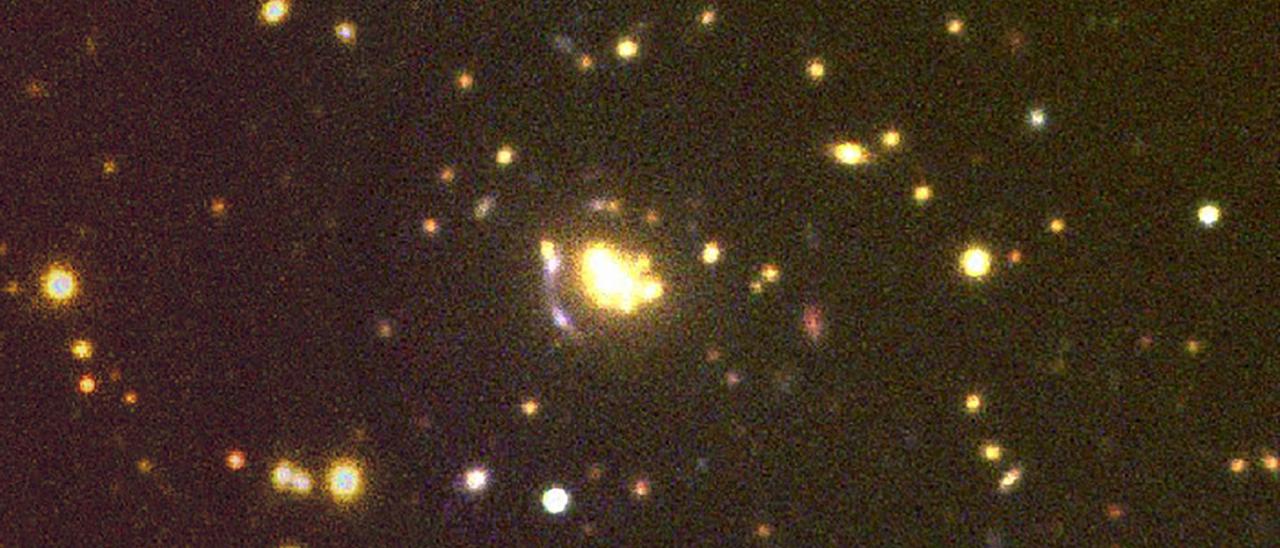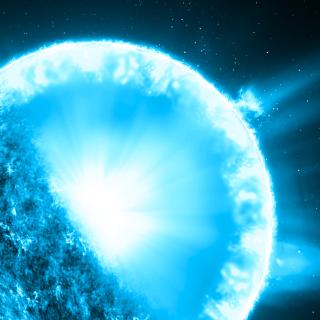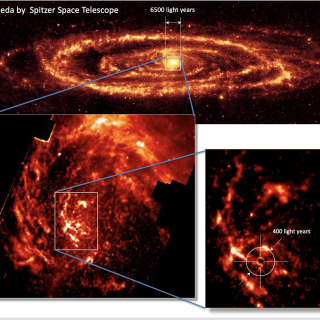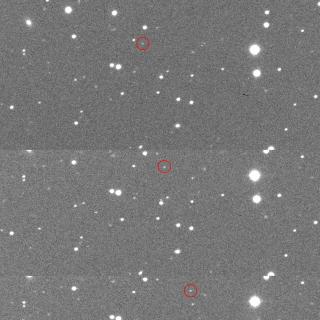An international team led by the group of Cosmology with Galaxy Clusters of the Instituto de Astrofísica de Canarias (IAC), including researchers from the University of Paris-Saclay (France) and the Max Planck Institute for Extraterrestrial Physics (Garching, Germany) has finished the optical characterization of new clusters of galaxies in the northern hemisphere, detected first by the Planck satellite using tjhe Suyaev-Zel’dovich signal. These studies allow more accurate determination of the mean matter density in the universe and other cosmological parameters.
The observations, which have lasted for over 4 years, have been made with the telescopes of the Roque de los Muchachos Observatory (Garafía, La Palma) within two international projects, including a Programme of International Time. More than 400 sources associated with Sunyaev-Zel’dovich emission have been studied, and 221 new clusters of galaxies have been characterized using photometry and spectroscopy, with the Gran Telescopio Canarias (GTC), the Telescopio Nazionale Galileo (TNG), the William Herschel Telescope (WHT), and the Isaac Newton Telescope (ING), the last two forming the Isaac Newton Group of Telescopes (ING).
The Sunyaev-Zel’dovich Effect
The Sunyaev – Zel'dovich (SZ) effect is caused by distortion of the cosmic microwave background radiation (CMB) in the direction of a galaxy cluster, due to a mechanism called the inverse Compton effect. This mechanism takes place when the electrons of the hot gas in the clusters interact with the photons of the CMB as they pass through the cluster. This causes a distorsion in the spectrum of the CMB.
By measuring the emission in the maps from Planck at different frequencies it is possible to detect the galaxy clusters causing the distorsion. The SZ effect does not depend on the distance of the cluster producing it, so it is necessary to characterize these SZ sources, identifying the clusters which cause them, finding their distances and masses so that they can be used for later cosmological studies.
In the past decade, this technique has been used to make catalogues of clusters of galaxies using data from radiotelescopes such as the South Pole Telescope (SPT), the Atacama Comology Telescope (ACT), and the data obtained from space by the Planck satellite. In 2013 and 2015 the Planck consortium published two catalogues, PSZ1 and PSZ2, which jointly include almost 2,000 sources detected over the whole sky.
"These examples -explains José Alberto Rubiño Martín, astrophysicist at the IAC and PI on the project- are especially useful in cosmology because the proportion of clusters of galaxies by mass and distance is very sensitive to the parameters of the cosmological model, and gives an independent way to determine them, and compare them with other techniques (supernovae, the Cosmic Microwave Background...)". Many of the SZ sourcesin these catalogues concide with clusters already known. But one third of them don't, so it is necessary to validate and characterize them. In this context, an important contribution by the IAC to the Planck consortium (ESA) in recent years has been the characterization by the telescopes at the Roque de los Muchachos Observatory of the SZ sources in the PSZ1 and PSZ2 catalogues which are visible from the Canaries.
Methodology
The method of observing consisted, in the first place, of obtaining deep optical images in the direction of the SZ sources, with which it was possible to localize the regions with concentrations of galaxies, obtain the first redshift (z) estimates by photometryc, and estimate the richness of the detected clusters. The optical validation of the clusters as true counterparts to the SZ sources was based on the distance from the peak of the SZ emission and on their richness.
In a second step, the clusters were observed using techniques of multi-object spectroscopy, using the OSIRIS (GTC) and DOLORES (TNG) spectrographs. The more distant clusters (with z>0.4) were observed with the GTC and the nearer clusters (z< 0.4) with the TNG. Multi-object spectroscopy allows us to obtain the radial velocities of many galaxies within each cluster, with which it is possible to calculate their velocity dispersions, and finally to obtain their dynamical masses.
In other words, the velocities with which the galaxies move tell us how much mass their is in the clusters which host them. We expect that, given the detection sensitivity of the instruments on the Planck satellite, only the most massive galaxies with masses greater than 1 or 2 times 10*14 solar masses can produce a detectable SZ effect, and so, be realisitic sources of this emission.
"We have made a major observational effort, in which we have explored 50 square degrees of sky, and have obtained over 10,000 spectra of galaxies" -explains Alina Streblyanska, an astrophysicist at the IAC and a member of the research group-, and we have placed all of the data in archives with public access".
Applying this technique, over 400 SZ sources with optical counterparts hitherto unknown have been studied, allowing the confirmation and characterization of 221 new clusters of galaxies.The remaining objects (around 40% of these sources) do not show detectable counterparts, and could be associated with false detections due to emission in the SZ maps of Planck with low signal to noise ratio.
“This process of detailed characterization of the catalogues is definitive for finding rigorously the selection function of the Planck satellite in these large maps of the sky in the microwave range” -notes José Alberto Rubiño-. This knowledge is essential for cosmological studies, which can then be performed with precision”.
“Some 40% of the sources studied showed an almost perfect relation with the thermal emission of dust within our Galaxy in the 857 GHz band -explains the IAC researcher and team member Rafael Barrena-, which confirms that the main source of low signal-noise contamination of the SZ effect on the Planck maps is caused by non-gaussian background sources, mainly linked with the diffuse thermal emission from dust clouds in the Milky Way”.
The results of this research have been published in 6 scientific articles in the journal Astronomy & Astrophysics, which were headed up during these past years by José Alberto Rubiño (PI), Rafael Barrena and Alina Streblyanska (Postdoctoral researchers), and A. Aguado Barahona (doctoral student of the IAC and the ULL).
“Now, the next step is to determine the relation between the masses of the clusters obtained using the SZ effect, and that determined dynamically, in order to study any biases in the estimates of masses using these methods. Our preliminary studies suggest a value of Msz/Mdyn of around 0.9”, adds Antonio Ferragamo, who recently completed his doctorate at the IAC, in this line of research.
“If we are able to determine this relation within an accuracy of 2% or 3%, we will be able to improve on the precision of the cosmological parameters, basically the normalization of the power spectrum (σ8), the density of ordinary mass (Ωm) and, maybe, restrict the masses of the three families of neutrinos. This is our final target”, says Rubiño.
According to Rafael Barrena, “these results could shed light on the discrepancies between the results of estimates of σ8 using CMB data and those from other experimental techniques, such as that based on the abundance of clusters of galaxies”.
This research in observational cosmology with galaxy clusters will be complemented in the near future by projects starting up, such as the WEAVE Cosmological Cluster Survey (WCC), in coordination with the Leiden Observatory (The Netherlands) and the University of Bologna (Italy), among others, and the NIKA2 LPSZ Optical Follow-up, in collaboration with the University of Grenoble-Alpes (France).
Other IAC researchers who have participated in this project are Ricardo Génova, Inés Flores, Angela Hempel, Heidi Lietzen, Denis Tramonte and Rafael Rebolo.
Related articles:
Barrena et al. (2020): https://arxiv.org/pdf/2004.07913.pdf
Aguado-Barahona et al. (2019): https://www.aanda.org/articles/aa/pdf/2019/11/aa36034-19.pdf
Barrena et al. (2018): https://www.aanda.org/articles/aa/abs/2018/08/aa32315-17/aa32315-17.html
Streblyanska et al. (2019): https://www.aanda.org/articles/aa/pdf/2019/08/aa35674-19.pdf
Streblyanska et al. (2018): https://www.aanda.org/articles/aa/abs/2018/09/aa32306-17/aa32306-17.html
Planck intermediate results. XXXVI: https://www.aanda.org/articles/aa/pdf/2016/02/aa26345-15.pdf
Contact:
- Rafael Barrena: rbarrena [at] iac.es (rbarrena[at]iac[dot]es)
- José Alberto Rubiño: jalberto [at] iac.es (jalberto[at]iac[dot]es)




